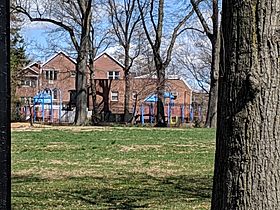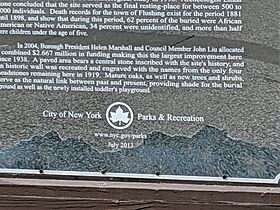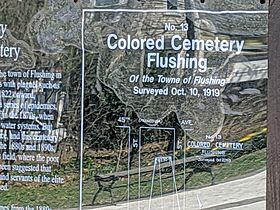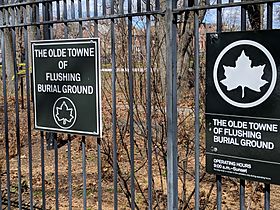Old Town of Flushing Burial Ground facts for kids
Quick facts for kids |
|
|
The Olde Towne of Flushing Burial Ground
|
|

Center stone at Plaza
|
|
| Location | 165th St. and 46th Ave., Flushing, New York |
|---|---|
| Area | 3.5 acres (1.4 ha) |
| Built | 1840 |
| NRHP reference No. | 100002079 |
| Added to NRHP | February 2, 2018 |
Old Town of Flushing Burial Ground is a historic cemetery located in Flushing, Queens, New York City. It was established in 1840 and known as The Olde Towne of Flushing Burial Ground. It was the result of Cholera and Smallpox epidemics in 1840 and 1844, added by town elders north of Flushing Cemetery due to fears of contamination of church burial grounds. Once known as "Pauper Burial Ground", "Colored Cemetery of Flushing" and "Martins Field", it was purchased by the New York City Department of Parks and Recreation on December 2, 1914 and renamed in 2009 to "The Olde Towne of Flushing Burial Ground". It is co-located with a children's playground called "Martin’s Field". It was placed on the National Register of Historic Places in 2018.
Contents
History
George Washington, like other noted landowners, journeyed to Flushing: The community was a center of scientific horticulture. The cemetery's floral and arboreal beauty have become a memorial to Flushing's status as a center of horticulture to this day.
The town of Flushing suffered a Cholera epidemic circa 1840 and a Smallpox epidemic in 1844. Fears that the infected dead bodies would contaminate the church burial grounds the town elders purchased the land from the Bowne family and created a separate burial ground to be used for the infected to be buried in. By 1854 medical science had progressed and improved hygiene helped ward off such diseases, fewer epidemics resulted in a lessened need for the separate unconsecrated graveyard and it fell into disuse. In the latter decades of that century it was set aside for use by the African American community. This was a result of editorials published in the Flushing Journal in the 1850s regarding the AME church running out of burial space. From about 1880 to its closing in 1898 it became primarily a burial ground for African-Americans and Native Americans. By 1914 the land was used as the ‘town commons’ or ‘village green’, and by 1930 was paved over and made into a park called ‘Martin's Field. In 1936 Robert Moses, NYC Commissioner of Parks spearheaded the initiative to re-purpose the green into a recreational space for children. As one of the many projects during the WPA period a modern children's playground was built on the site. It was during excavation that workers came across evidence of the previous usage as a burial ground. Found at the dig were remains which still had pennies over the eyes, an archaic practice that was also observed in excavation of the African Burial Ground in lower Manhattan.
By 1938, the new playground, with a wading pool, baseball field and swing sets opened to the public. The WPA's historical division conducted interviews with local citizens about the sites history as a burial ground for a permanent record. The only grave markers that remained was for the Bunn family – who were members of the AME church.
Archeological dig
In 1990, local activist Mandingo Tshaka helped publicize the history of the green, resulting in a $50,000 archaeological study in 1996 commissioned by the Parks Department. Archeologist Linda Stone concluded that the site served as final-resting place for between 500 and 1000 individuals. Death records for the town of Flushing exist for the period 1881–1898, showing that during this period, 62% of the burials were African American or Native American, 34% were un-identified, and more than half were children under the age of five.
21st century
In 2004, Queens Borough President Helen Marshall and NYC Councilmember John Liu allocated $2.667 Million in funding to renovate the park, the largest improvement since 1938. A paved area bears a central stone inscribed with the sites history, and a historic wall was recreated and engraved with the names from the only four headstones remaining in 1919. Mature oaks, as well as new trees and shrubs, serve as the natural link between the past and present, providing shade for the burial ground as well as the newly installed playground which was moved to the northern end of the site, above whose entrance is the designation, ‘Martins Field". It was placed on a sill system foundation so as not to disturb the land, and is accessible from the 165th street entrance. In 2009 a naming ceremony for the site was held and parks department signs were placed for ‘The Olde Towne of Flushing Burial Ground’ and ‘Martin’s Field".
In 2018 Mayor Bill de Blasio and members of the community along with Queens Borough President Melinda Katz announced at the site that $1.63 million in funding was allocated to reconstruct a commemorative plaza at the site, including a butterfly garden, new benches and directions which will be written in a variation of the Lenape tongue, an Algonquin language, recognizing the native American dead buried there. A circular plaza, bearing the names of the Manitou's of the N, S, E & W in the language of the Algonquin is featured. It has been designated to the New York State and National Register of Historic Places.
In 2019, artist Alexandria Smith created an exhibition at the Queens Museum, Monuments To An Effigy, which sought to bring remembrance to the women who were buried at this site.
Gallery










